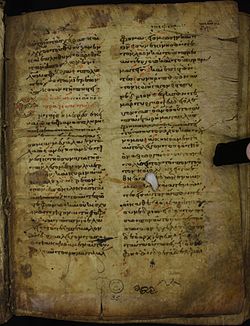Top Qs
Timeline
Chat
Perspective
Lectionary 170
New Testament manuscript From Wikipedia, the free encyclopedia
Remove ads
Lectionary 170, designated by siglum ℓ 170 (in the Gregory-Aland numbering) is a Greek manuscript of the New Testament, on parchment leaves. Palaeographically it has been assigned to the 14th century.[1] Scrivener dated it to the 12th or 13th century.[2] Formerly it was labelled as Lectionary 68a.[3] Scrivener by 65a.[2]
Remove ads
Description
The codex contains lessons from the Acts and Epistles lectionary (Apostolarion), on 160 parchment leaves (26.4 cm by 19.7 cm), with lacunae at the beginning and end.[3] The text is written in Greek minuscule letters, in two columns per page, 28-29 lines per page.[1] It is ill written.[4] It contains musical notes in red.[2]
The text reaches from the second Sunday after Easter, through the Ascension, Pentecost, to the sixteenth week after Pentecost. The Menology (folios 114 v – 160) has almost no lessons given at length, but overflows with rubrical directions.[4]
Remove ads
History
The manuscript was purchased in 1870 by Angela Burdett-Coutts. Formerly it was held in Burdett-Coutts III. 24 in London.[3]
The manuscript was examined by C. R. Gregory, who saw it in 1883.[3]
The manuscript is not cited in the critical editions of the Greek New Testament UBS3,[5] but it was cited in UBS4.[6]
Since 1922 the codex is located in the University of Michigan (Ms. 35) at Ann Arbor.[1]
Remove ads
See also
Notes and references
Bibliography
External links
Wikiwand - on
Seamless Wikipedia browsing. On steroids.
Remove ads

